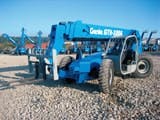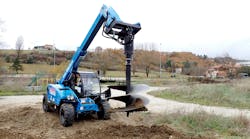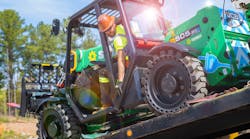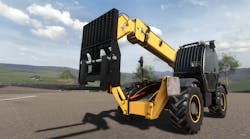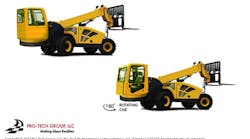If you are not familiar with the Genie GTH-1056 telehandler, you may recognize the similarities between it and the Terex TH1056-C. Genie Industries, Redmond, Wash., took responsibility for Terex telehandlers back in 2005, quickly changing the nomenclature to GTH-1056 and the color to its signature blue and gray. The all-new GTH-1056 was not quite ready for the Showcase, but was officially introduced in February.
Instead of wasting time on discussing a now out-of-production machine, we are reviewing improvements made to the new product. Genie arranged for us to see the new telehandler in January.
The new Genie GTH-1056 is a clean-sheet approach with the most notable difference being the position of the engine, which has been moved back as far as possible in the all-new 2-foot-shorter, 15-inch-lower frame. The shift in position creates more counterweight and trims 2,000 pounds from the overall GVW while actually increasing the load charts.
If there is ever a major engine problem, provisions have been made to slide the engine out the back side with a forklift. The new machine also incorporates a hydraulic system that is load sensing and pressure compensating.
The shorter frame and new 55° turning axles significantly improve the outside turning radius by nearly 4 feet. Since 1988, Terex has used a roller bearing boom. While it is a major debate in the industry over which is better, Genie has moved away from rollers to the more common poly slide pads. The hose for auxiliary hydraulics has been moved inside the boom, and the hydraulic and fuel tanks have been redesigned. Sitting side by side, a lockable steel panel not only restricts access to the oil tank's fill point, it also secures the battery. The plate's robustness also protects everything from falling objects.
Now built in-house, the cab features a new dashboard and interior. A single joystick controls boom functions and sway. The rear-axle stabilization system has vastly improved, now allowing the rear axle to free-float with boom angles up to 59°. Above 59°, the axle floats at a dampened rate. The only time the axle locks is when the boom is above 60°. Maximum length of boom extension is expected to be 48 feet.
Pneumatic tires are now standard equipment. The quick-attach system also has been redesigned to be compatible with the widely accepted SkyTrak system.

